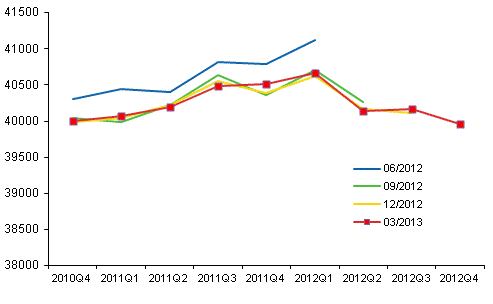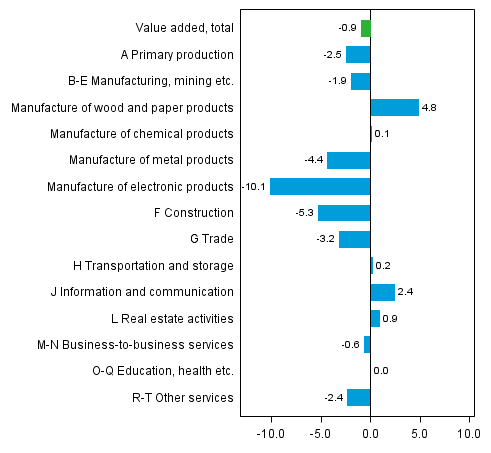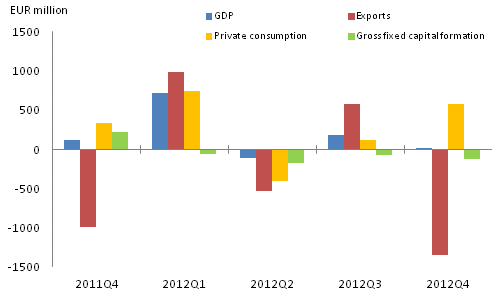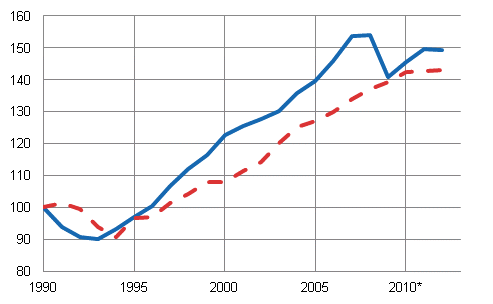1. Gross domestic product decreased by 0.2 per cent in 2012
The volume of GDP fell by 0.2 per cent last year. Over the October to December period, gross domestic product decreased by 0.5 per cent from the previous quarter. Compared with the last quarter of 2011, GDP contracted by 1.5 per cent.
The economic development in 2012 was uneven and weakened towards the end of the year. In the first quarter, GDP still grew clearly, partly caused by the lively motor vehicle trade as buyers anticipated benefits from the changed motor vehicle tax that took effect in April. In the second quarter, GDP fell by one per cent, and in the last two quarters of the year, less GDP was accrued than in the previous year.
Figure 1. Revisions - seasonally adjusted volume of GDP by release

When comparing with the previous quarter, the volume of GDP fell in the second and fourth quarter but, based on the revised data, the third quarter indicated a marginal growth. This means that the general criterion for recession of two successive quarters with a decline in the volume of GDP is not fulfilled. However, as the GDP for the whole year is lower than in the previous year, last year can be regarded as a year of recession in the Finnish economy.
According to preliminary data compiled by Eurostat, GDP in the EU-27 area fell by 0.5 per cent in the fourth quarter of 2012 compared to the previous quarter. In the whole year 2012, GDP in the EU-27 area decreased by 0.3 per cent.
1.1. Production
In the last quarter, the volume of value added in the entire economy decreased by 0.1 per cent from the previous quarter. The value added fell by 0.2 per cent over 2012. The biggest reason behind the drop in value added in 2012 was the electrical and electronics industry. Value added was increased most by information and communication and trade and business services (industries M to N) in 2012.
Figure 2. Value added by industry in the 4th quarter 2012 (chain-linked volumes, working day adjusted), percentage change on corresponding quarter of previous year

The volume of value added in primary production, that is, agriculture, forestry and fishery, went up by 0.8 per cent in October to December from the previous quarter. In the whole of 2012, the volume of primary production fell by 1.1 per cent, however. In agriculture, the value added decreased by 3.8 per cent last year. In forestry, the value added grew by 0.1 per cent in 2012.
In the last quarter, the value added of industries (industries B to E) decreased by 1.1 per cent from the previous quarter. Value added grew by 1.1 per cent in the forest industry but fell by 1.8 per cent in the metal industry. Value added in the electrical and electronics industry contracted by 6 per cent. From October to December, the volume of value added in construction diminished by 1.4 per cent from the previous quarter.
In the whole of 2012, the volume of value added in manufacturing decreased by 1.8 per cent. Value added fell by 2.3 per cent in the forest industry but grew by two per cent in the chemical industry. In the metal industry, value added went up by 0.6 per cent but fell by 9.1 per cent in the electrical and electronics industry. Value added in construction decreased by 2.3 per cent from the previous year.
In the October to December, period the value added of service industries remained on level with the previous quarter. Trade contracted by one per cent but transport services gained 0.7 per cent. Real estate activities remained at the level seen in the previous quarter but business services (M to N) decreased by 1.5 per cent.
In the whole of 2012, the volume of value added in service industries went up by 0.5 per cent. In trade, value added fell by 0.5 per cent and in transport services by 0.1 per cent. Information and communication increased by 2.9 per cent. Real estate activities grew by 1.9 per cent and business services (M to N) by 2.2 per cent. Value added in financial intermediation and insurance diminsihed by 0.1 per cent last year.
1.2. Imports, exports, consumption and gross fixed capital formation
The volume of total demand in the national economy contracted by 1.6 per cent in 2012. Demand was particularly depressed by exports, construction gross fixed capital formation and change in inventories. The balance for goods and services, which is the difference between imports and exports, showed a deficit of EUR 1.2 billion last year.
Figure 3. GDP and expenditure components, change from previous quarter (seasonally adjusted, at current prices)

Over the October to December period, the volume of exports fell by 4.4 per cent from the previous quarter. The volume of exports decreased by 1.4 per cent over 2012. Exports of goods contracted by 1.2 per cent and those of services by 1.8 per cent.
From October to December, the volume of imports increased by 1.5 per cent from the previous quarter. The volume of imports decreased by 3.7 per cent over 2012. Imports of goods fell by 6.6 per cent, but imports of services grew by 4.6 per cent.
In the last quarter, the volume of private consumption went up by 0.9 per cent from the previous quarter. The volume of public consumption expenditure diminished by one per cent. In the whole of 2012, the volume of private consumption increased by 1.6 per cent and that of public consumption expenditure by 0.8 per cent.
In the last quarter, the volume of gross fixed capital formation grew by 2.5 per cent from the previous quarter. Construction gross fixed capital formation decreased by 2.5 per cent. The volume of gross fixed capital formation in machinery, equipment and transport equipment fell by half-a-per-cent.
The volume of gross fixed capital formation contracted by 2.9 per cent over 2012. Gross fixed capital formation in residential buildings diminished by 4 per cent and gross fixed capital formation in non-residential buildings by 6.6 per cent. The volume of civil engineering gross fixed capital formation remained at last year's level. The volume of gross fixed capital formation in machinery, equipment and transport equipment decreased by 0.8 per cent. Other gross fixed capital formation, mainly consisting of software gross fixed capital formation, improved by 1.6 per cent.
1.3. Employment
The number of employed remained at the previous quarter's level in the fourth quarter. The number of hours worked in the national economy fell by 0.2 per cent from the previous quarter. In the whole of 2012, the number of employed persons grew by 0.3 per cent but the number of hours worked decreased by 0.2 per cent.
Labour productivity, or the volume of gross value added per hour worked, remained at the same level as in 2011, but was still over three per cent lower than in 2007.
According to Statistics Finland’s Labour Force Survey, the rate of unemployment in the October to December period was 7.0 per cent. In the corresponding period of 2010 it stood at 6.9 per cent. The unemployment rate for the whole of 2012 was 7.7 per cent.
1.4. Prices went up
The economy’s overall price level is estimated to have risen by 2.8 per cent last year as measured by the GDP price index.
Last year, the Consumer Price Index also rose by 2.8 per cent, but the price index of household consumption expenditure in National Accounts went up by 2.6 per cent. In National Accounts, the prices of housing services are measured with changes in market rents, whereas the Consumer Price Index also takes into consideration the expenditure on owner-occupied housing. The methods used in National Accounts and in the Consumer Price Index for measuring development in the prices of insurance and financial intermediation services also deviate from each other.
The terms of trade weakened further, because import prices rose by 3.6 per cent and export prices less, by 1.4 per cent.
1.5. National income contracted by 2 per cent in real terms
Net national income grew by 1.5 per cent in nominal terms, but contracted by 2 per cent real terms last year, and was EUR 30,070 per capita. Finland’s gross national income was EUR 194 billion, i.e. the same as GDP. Gross national income fell by 1.6 per cent in real terms, i.e. more than gross domestic product because the terms of trade weakened and primary income from abroad decreased.
Households’ wage and salary income went up by 3.2 per cent and employers’ social insurance contributions by 2.6 per cent. Altogether, compensation of employees rose to 61.2 per cent of the national income. The respective proportion in the previous year was 60.3 per cent. Property and entrepreneurial income in the national economy decreased by 3.9 per cent and their share of the national income stood at 23.3 per cent. The respective proportion in the previous year was 24.7 per cent.
1.6. Non-financial corporations’ profits almost unchanged
Non-financial corporations' operating surplus describing profits from their actual operations contracted by 2.1 per cent from the previous year. Their entrepreneurial income grew by 0.3 per cent and was still clearly lower than in the peak year of 2007. Entrepreneurial income also takes into consideration property income and paid interests, and corresponds roughly with profit before payment of taxes and dividends.
Last year, non-financial corporations paid 12 per cent less direct taxes and 14 per cent less dividends than in the year before.
Non-financial corporations’ net lending, or financial position, showed a surplus of EUR 7.7 billion, as against EUR 2.8 billion in the previous year. The financial position improved thanks to a clear reduction in inventories. Their fixed investments in Finland grew by 0.6 per cent last year.
Financial corporations’ interest income (financial intermediation services indirectly measured) decreased, but commission income increased. The credit and deposit stock continued to rise but the level of interest rates was lower than in the year before. The financial position of insurance and financial corporations showed a surplus of EUR 1 billion.
1.7. General government deficit 1.9 per cent of GDP
Last year, the financial position of central government showed a notable deficit for the fourth successive year. The deficit (net borrowing) was EUR 7.4 billion, while one year before it was EUR 6.4 billion. The deficit increased, in particular because current transfers paid grew more than tax revenues.
State revenues from taxes went up by 2.3 per cent. Revenues from indirect taxes, for instance from value added tax, grew most. By contrast, revenues from direct taxes decreased because corporation tax revenue fell.
Current transfers to local government (incl. repayments of value added tax) went up by 3.4 per cent. Current transfers to social security funds grew by 6.8 per cent. In nominal terms, final consumption expenditure rose by 3.9 per cent and investments by 3.7 per cent.
The deficit of municipalities and joint municipal boards was EUR 2.1 billion, more than ever before. Tax revenues received by municipalities grew only by one per cent because corporation tax revenue decreased. Final consumption expenditure went up by 4.9 per cent in nominal terms and investments are estimated to have grown by 6.2 per cent.
The financial position of employment pension funds weakened as well from last year. The surplus was now EUR 4.7 billion, while one year before it was EUR 5.2 billion. Revenues from pension contributions grew by roughly the same amount as paid employment pensions but property income decreased. Value changes in investments are not taken into consideration in the financial position. The surplus of other social security funds amounted to EUR 0.4 billion.
Non-financial corporations’ net lending, or financial position, showed a deficit of EUR 4.5 billion, while the deficit was EUR 2.1 billion in the previous year. The so-called EDP deficit defined in the European Union's Growth and Stability Pact totalled EUR 3.7 billion, or 1.9 per cent of gross domestic product. It differs from general government net lending in that it also takes into account the effect of swap agreements on interest expenses.
The so-called EDP debt, or consolidated gross debt, of general government grew to over EUR 103 billion. Relative to GDP, it increased to 53.0 per cent, i.e. by four percentage points. The growth was also affected by the fact that the borrowing of the European Financial Stability Facility EFSF is recorded as part of the gross government debt of the countries that have provided guarantees. During 2012, this debt grew from EUR 0.3 billion to EUR 2.7 billion.
Statistics Finland will publish the deficit and debt data that must be reported to the EU Commission on 28 March 2013. The deficit and debt data published here may become revised in that connection.
The proportion of public expenditure of gross domestic product was 56.0 per cent. In the previous year the proportion was 55.0 per cent.
The tax ratio, or the proportion of taxes and statutory social security contributions of GDP, was 43.6 per cent last year. The tax ratio increased by 0.1 percentage points from the previous year.
1.8. Growth in households’ real income has almost stopped
Households’ disposable income grew by 2.8 per cent in nominal terms and by 0.2 per cent in real terms. Households’ adjusted disposable income increased by 3.2 per cent in nominal terms and by 0.3 per cent in real terms. Adjusted income also takes into consideration the individual services that general government and organisations produce for households, such as educational, health and social services.
Figure 4. Volume of Finland’s GDP (unbroken line) and households' adjusted disposable income (broken line), 1990=100

Wages and salaries received by households went up by 3.2 per cent and social benefits by 5.6 per cent. Wage and salary income was put up by a risen level of earnings, not employment. Households’ property and entrepreneurial income decreased by 0.3 per cent.
Direct taxes paid by households increased by 3.3 per cent and consumption expenditure by 4.5 per cent. Consumption expenditure exceeded disposable income, which resulted in a negative savings ratio, or savings relative to disposable income, of -0.5 per cent.
Households’ fixed investments went up by 1.3 per cent in nominal terms, housing construction decreased slightly. Households’ financial position showed a deficit of EUR 6.1 billion.
Households’ indebtedness rate was 118.6 per cent at the end of last year, in other words, it grew by 2.9 percentage points over the year. The indebtedness rate expresses the ratio between the loans and annual disposable net income in accordance with financial accounts. Annual financial accounts data on the situation at the end of the year are preliminary assessments.
1.9. Next revisions in June and July 2013
Data concerning the first quarter of 2013 will be released on 5 June 2013. National Accounts for 2012 with more detailed data contents will be released on 11 July 2013. At the same time, the data for 2010 and 2011 will be revised.
These preliminary data are based on the information on economic development available by 22 February 2013. More information on the national accounts methods can be found on Statistics Finland’s website at: http://tilastokeskus.fi/til/vtp/men_en.html and http://tilastokeskus.fi/til/ntp/men_en.html
Source: National Accounts, Statistics Finland
Inquiries: Olli Savela 09 1734 3316, Aila Heinonen 09 1734 3338, skt.95@stat.fi
Director in charge: Leena Storgårds
Updated 1.3.2013
Official Statistics of Finland (OSF):
Annual national accounts [e-publication].
ISSN=1798-0623. 2012,
1. Gross domestic product decreased by 0.2 per cent in 2012
. Helsinki: Statistics Finland [referred: 24.4.2025].
Access method: http://stat.fi/til/vtp/2012/vtp_2012_2013-03-01_kat_001_en.html

